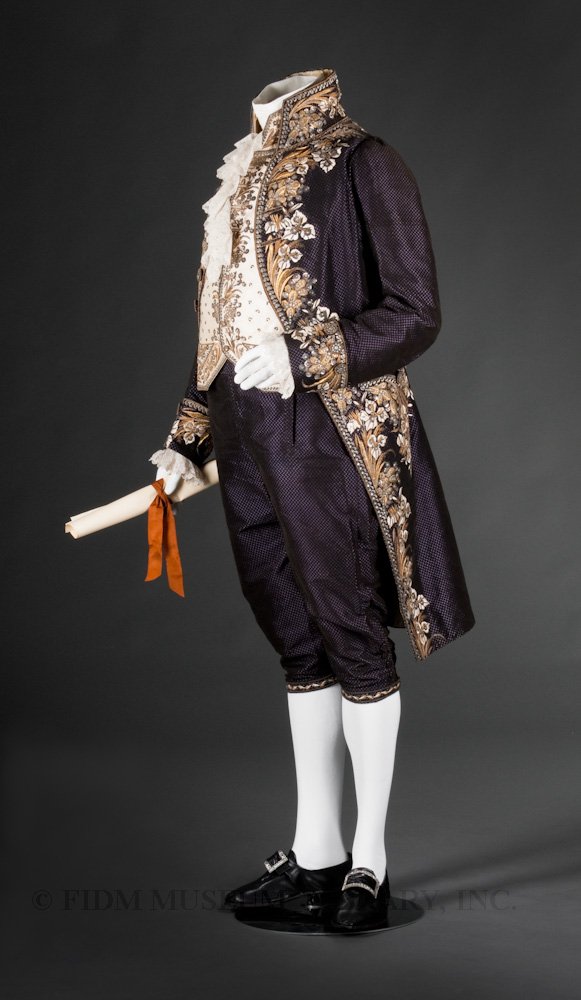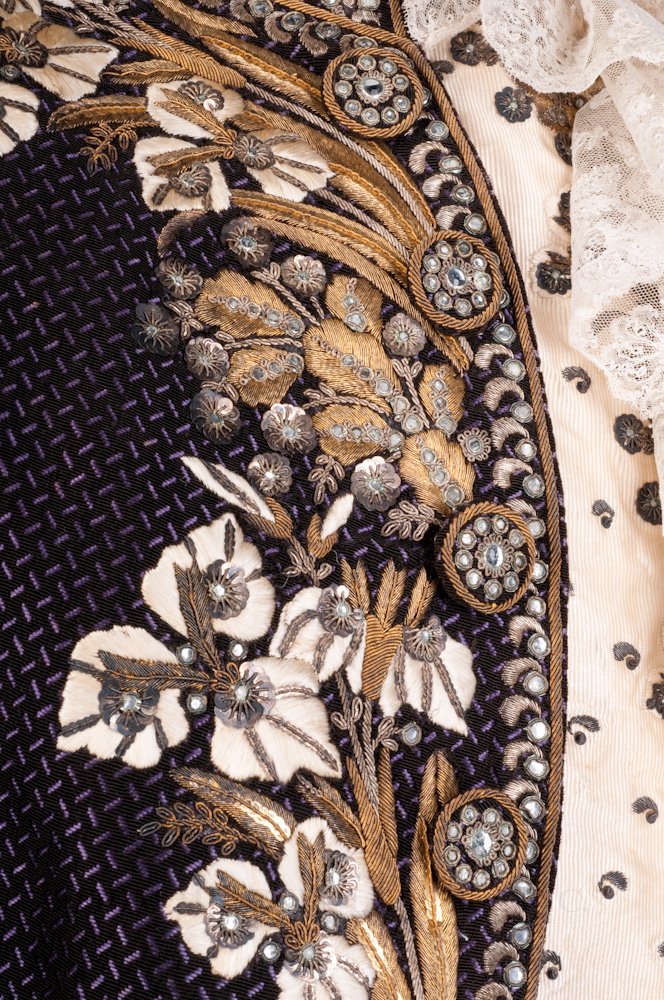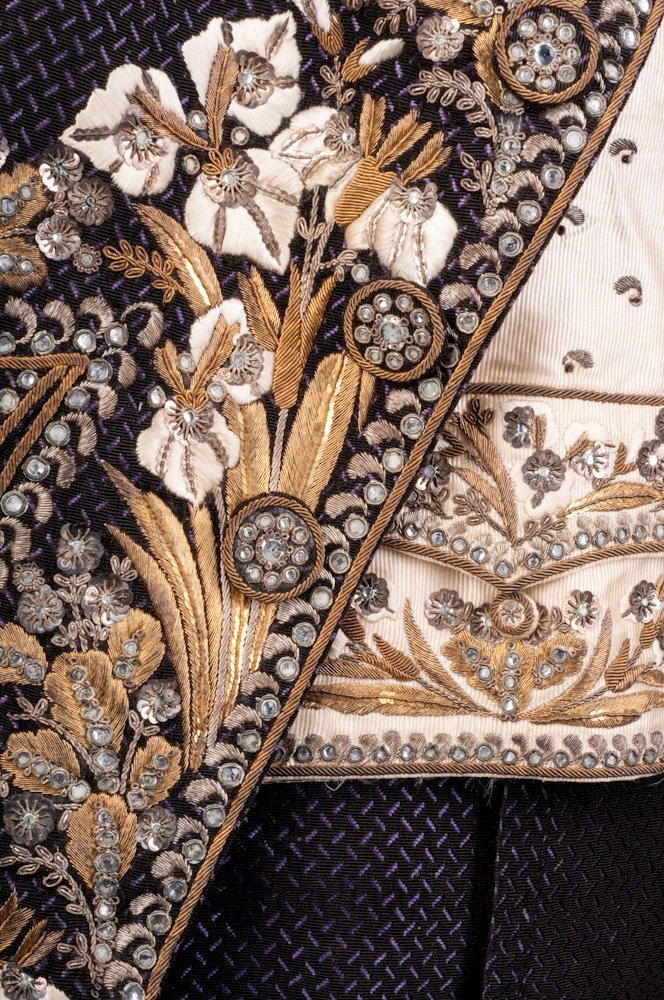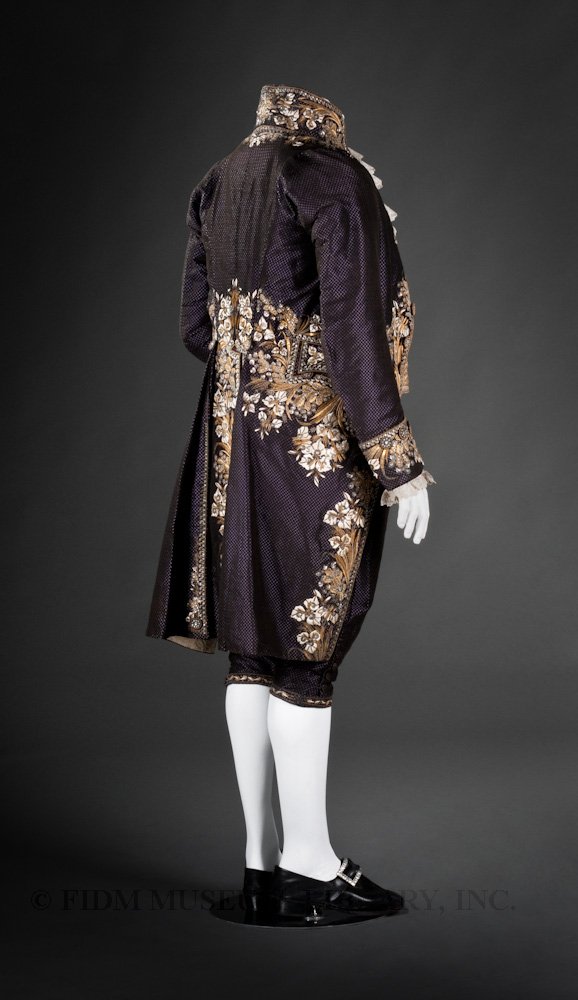Since our FABULOUS! exhibition opened in September, we've featured selected exhibition highlights on our blog. As FABULOUS! closes tomorrow, this post will be our final installment in the series. Want to revisit favorite pieces from the exhibition? Click here for a complete listing of FABULOUS! blog posts.
This final FABULOUS! post features a stunning early 19th century court suit with a fascinating provenance. Consisting of a jacket and breeches of aubergine silk velvet decorated with silk and metallic embroidery and a cream silk faille vest, this court suit would be a highlight of our collection with or without a known provenance. But its excellent condition and documented provenance make it even more historically important. Created late in the reign of Emperor Napoleon Bonaparte (r. 1804-1814/15) by handloom weavers and master embroiders, its uncut voided velvet with gold, silver, rhinestone, and sequin decoration is truly regal. It was donated to the FIDM Museum in 2008 by the family of Johann Hummel's great-great grandson, Michael Hummel. We featured a glimpse of this court suit on our blog in 2009, a few months after it was donated.
 Court suit
Court suit
Uncut voided silk velvet, silk faille, silk embroidery floss, gold & silver embroidery purl & frieze, rhinestone & metal sequins
c. 1810-14
Paris, France
Gift of Yvonne Hummel
2008.947.2A-C
Austrian composer Johann Hummel (1778-1837) commissioned this court suit for an important performance, possibly at the Congress of Vienna (1814-1815), which was held to reposition the boundaries of Europe after Napoleon’s defeat at the Battle of Waterloo. European courts vied with one another for political survival, particularly as Napoleon overthrew ancient monarchies and filled their vacant thrones with his own family members. When paying homage at court, a splendid appearance was de rigueur. By the time he commissioned this suit, Hummel was a successful composer. A contemporary biographer noted: “Having been always very prudent in the management of his affairs, M. Hummel is now in the possession of an independent fortune, such as enables him to keep a carriage, and to live in every respect in the style of the opulent and grand.”1
 2008.947.2A-C Jacket & vest detail
2008.947.2A-C Jacket & vest detail
White satin stitch embroidery forms iris motifs, while gold metallic embroidery creates the stems. The buttons are embellished with gold braid and small glass ornaments.
Born in modern day Slovakia, Johann Hummel's family moved to Vienna when they recognized that their child was a musical prodigy. Due to his exceptional talent, Hummel began studying under Mozart when he was only 7 years old. When he was 9, Hummel's family embarked on an extensive European tour. During this four-year tour of European capitols, Hummel honed his composition and performance skills by performing for European royalty, including King George III and the Prince of Orange. Returning to Vienna, Hummel studied with Antonio Salieri and Albrechtsberger. Beethoven, though several years older than Hummel, was a friend and musical rival. Hummel was extremely well-known during his life-time, but his style of classical composition fell out of favor towards the end of his life. His work was almost entirely forgotten until a Hummel score was re-discovered in the late 1950s. Listen to a Hummel composition here.
 2008.947.2A-C Detail showing jacket, vest & breeches.
2008.947.2A-C Detail showing jacket, vest & breeches.
At the time Hummel commissioned this court suit, court dress was increasingly distant from everyday dress. Though lavish, it was an event-specific uniform. By about 1800, luxurious fabrics and heavy embellishment were no longer in fashion for men's suits. Instead, men donned three-piece suits made of sturdy woolen fabrics, with little or no embellishment. Decorative court dress was a remnant of seventeenth and eighteenth century fashions, which favored an equal amount of embellishment for both men and women. In the nineteenth century, excellent tailoring, rather than extraordinary embellishment, would define a fashionable men's suit.
1 "Memoir of Johann Nepomuk Hummel." in The Harmonium, Number XVIII (London: W. Pinrock, June 1824) 104.



wow.
what else is there?
all that needlework…
wow.